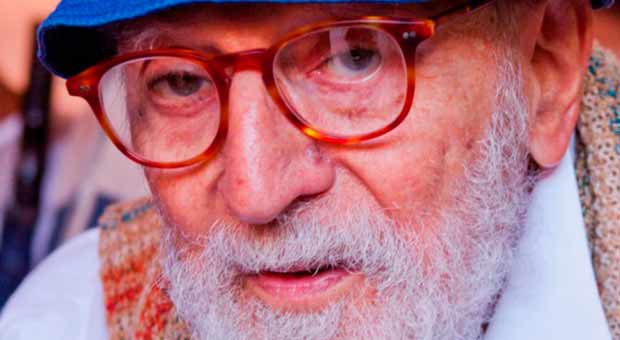Vittorio Garatti arrived once again in Cuba with sketches and a new piece in mind, just like 40 years ago with the desire to see his project-dream come true at last. Garatti, along with Roberto Gottardi and Cuban Ricardo Porro, conceived Art, Ballet and Music Schools in Havana. Porro’s was finished in 2009; while Gottardi’s and Garatti’s are still between ruins and construction. Spaces damaged by time and indolence, but filled with the hopes of its many lovers.
On this occasion he travelled to the Havana to open on Friday, March 7th, the exhibit Vittorio Garatti: Works and Projects, at the Wilfredo Lam Contemporary Art Center.
“He is an extraordinary man”, says Jorge Fernandez, Director of this center and curator of the exhibit. “He is very committed with his work. If I had to define him I would say he is perseverance, resistance, the fact of believing in what you do and never stop dreaming, which is what has kept him alive.”
The exhibition is a tour through his work: “his drawings with a special erotic feeling, some 3D molds of the school, the new mock-up he made for the Music Theater, which is a cathedral. He says he dreams about enjoying some day the piece Altagracia, by Carlos Fariñas, at that theater, which is not any piece: it is a parade and it is dedicated to Ernesto Che Guevara.”
This architect affirmed to Prensa Latina that this is one of the biggest exhibits he has ever had because it brings together all the stages in his career. “I’m thrilled with this homage which sets my work so high, giving details for those that are familiar with it and introducing it to the new generations”, he said.
Now he is working on a project called El Anillo del Caribe (The Ring of the Caribbean) which will connect islands and Caribbean countries by sea and train. He worked in Cuba until 1974. And he must have left the country “dreaming about the culmination of his work”, Fernandez states. The schools are extremely transgressing as they have been outlined with that concept of organic architecture, which regenerates itself; they have been outlined from the structural and the social perspectives; that’s why he found some inspiration in Wifredo Lam’s pieces: El tercer mundo, La jungla… Garatti’s architecture also anticipated many things: postmodernism, many concepts that are handled today in architecture”.
There are also other references in his work. “From this urbanism by John Willis, 1760, La Alhambra, Francesco Borromini, Alberti… He also finds interesting those architects that unfortunately couldn’t finish their projects for different reasons that range from financing to slackness and incomprehension”.
“Vittorio is a utopian man, like Tatlin, who designed that huge monument, that great spiral that was never built. Perhaps Russia, in the midst of so many changes, was not ready for a building of that caliber. Architecture is probably characterized by that “sin” of investments and budgets”, Fernandez adds.
Is Cuba ready for Garatti’s architecture?
Jorge Fernandez: Cuba was not ready and neither the world. He recalls that when he went to Italy and explained the project people didn’t understand it as it always occurs with transgressing pieces. At that time there were many aesthetic differences as well, starting with the architects themselves; and sometimes aesthetic differences are transferred to the political sphere and bring about meaningless political arguments. Besides, Vittorio is a convinced communist and has never ceased to be one. However, here schools were not understood as they were supposed to. There was no sensitivity, except for Fidel, who publicly declared that people tried to convince him that these schools were not functional and that it was impossible to finish that work, and therefore he had to face arguments because many people were against these schools.
Do these schools stand the chance of being brought to completion?
Jorge Fernandez: These are complex times and this project demands investments. I believe that the most important thing is that in Cuba there is sensitivity in all spheres, first towards schools, towards the significance of their completion, and then towards finding the necessary financing, the aid. Vittorio knows that Cuba alone can not undertake the costs of that school, there needs to be political will to create an international movement to look for financing. We have to try, why not? We cannot stop thinking about the future due to present circumstances.
Source Cubadebate










